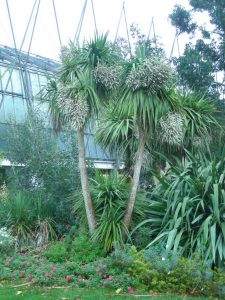Much needed at this cool, damp, darkening time of the year. A reminder of warm climes in the Southern Hemisphere. Cordyline australis is established in the beds south of the glasshouse foyer. The brown trunk is covered in a plating bark of corky appearance. The single trunk splits and branches at a height of approximately two meters once flowering age is reached. At each leaf base is a dormant auxiliary bud, essential to the plants survival. You can see regenerative ability in one of the cut trunks. In New Zealand where these grow as native flora the Maori used to grow and fell C. australis on a four year cycle to produce fructose. Steamed from cut stem sections this sweetening syrup has a biter aftertaste. Crowning the top of the plants is a mop of sword shaped leaves. Initially erect, with age and weather they bend and over time turn brown and fall against the trunk. Growing from some of the trunks are remnants of auxiliary aerial roots. These appear beneath the brown leaves gathered around the trunk where a moister atmosphere pervades. They soon dry and wither as this protection falls to the ground.
The plants are now all producing abundant quantities of small white berries each containing several black seeds. These are held in large panicles that droop down through the foliage. In warmer areas of Britain, often planted in seaside towns, self sown seedlings will result.
In the nursery are seedlings from an Unwin, father and son, collecting trip to New Zealand. The image shows the adventitious root system and more interestingly the vertical rhizome acting as the tap root growing down from the base of the shoot. The base of the mature trunk spreads concentrically to form a supporting base to the aerial growth. This is one of the few monocotyledonous trees that has secondary thickening, which differentiates the genera from most other monocotyledons.

